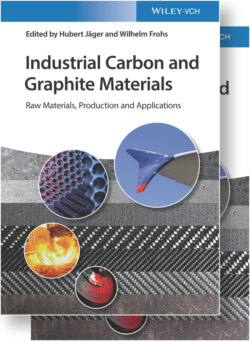Читать книгу Industrial Carbon and Graphite Materials - Группа авторов - Страница 300
6.1.3.2. Physical and Chemical Properties 6.1.3.2.1 Physical Properties
ОглавлениеPC is blocky, granular, and powdery in shape and black in color and is a porous carbonaceous solid with very little impurities (in general, ash is in a range of <3%). Its appearance depends on a production method and applications. The majority of PC produced using the chamber‐type coke oven is blocky, very hard, and in a shape like a columnar joint or a shape in which the bottom of a cone is protruded convexly. There are pores and cracks elongated in the direction of the major axis and parts of PC appear in silver gray color. There are two types of PC produced by the delayed coking process, needle coke used for a synthetic graphite electrode in electric arc furnace steelmaking and amorphous coke used in aluminum smelting. Needle coke is black and shiny in silver gray color and characterized with the elongated structure with the sharp tip at both ends. Pores and cracks with the cross section in a range of a few millimeters are observed mainly in the direction of the major axis. Amorphous coke is black in color and has the shape close to the rectangular parallelepiped or cube structure with rounded edges or the shape close to the sphere, and pores with the maximum cross section in a range of a few millimeters are observed randomly. The grain size of coke produced by the delayed coking process ranges from a size of fine powder to the dimension of a golf ball as the maximum diameter.
Needle coke is heat‐processed at 2000–3000 °C to convert to the majority of a synthetic graphite electrode and special carbon products as a products, but different cokes are used depending on the degree of graphitization according to the purpose. Coke used in aluminum smelting is used as a carbonaceous substance. Each property differs substantially (see the Section 6.1.3.2.2).
